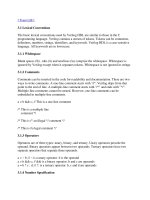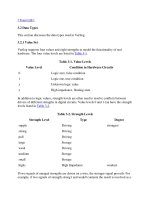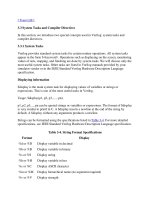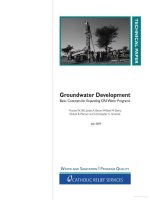Nutrition - Basic Concepts
Bạn đang xem bản rút gọn của tài liệu. Xem và tải ngay bản đầy đủ của tài liệu tại đây (139.62 KB, 10 trang )
NUTRITION: BASIC CONCEPTS
Describe how the state of nutrition may be assessed.
There are many methods of assessing the nutritional state –
none of them completely satisfactory.
᭹
Anthropometric measures
Height, weight, body mass index (Weight/Height
2
)
Fat measure indices: e.g. triceps skin fold thickness
Lean muscle indices: e.g. mid-arm circumference
᭹
Biochemical indices
Serum proteins: e.g. albumin; more of a late marker
because of the long half life. Other states of critical
illness may also affect the level. Other proteins
that have been measured: pre-albumin, transferrin,
retinol, all of which may be affected by the stress
response
24 h urinary creatinine: as a measure of the protein
turnover
᭹
Immunological indices
Total lymphocyte count
Immune function, e.g. tuberculin skin test, response to
mitogens. However, these are non-specific
᭹
Clinical markers
Physical appearance
Hand grip strength
Pulmonary function tests, e.g. vital capacity
From which sources may the energy requirements be
satisfied? How much energy do each of these
provide?
The predominant sources of energy are from carbohydrates
and lipid, but protein catabolism also yields energy.
᭹
Fats provide 9.3 kcal/g of energy
᭹
Glucose, 4.1 kcal/g
᭹
Protein, 4.1 kcal/g
SURGICAL CRITICAL CARE VIVAS
N
NUTRITION: BASIC CONCEPTS
᭢
161
N
NUTRITION: BASIC CONCEPTS
Define the respiratory quotient.
This is defined as ‘the ratio of the volume of the CO
2
pro-
duced to the volume of oxygen consumed for the oxidation
of a given amount of nutrient.’
Respiratory quotients for the oxidation of nutrients
᭹
Carbohydrate: 1.0
᭹
Fat: 0.70
᭹
Protein: 0.80
What are the disadvantages of using glucose as the
main energy source? How can this be overcome?
The problems of glucose are
᭹
As part of the stress response, the critically ill are often in
a state of hyperglycaemia and glucose intolerent.
Therefore, if glucose is the only source of energy, then
patients will not receive their required daily amount due
to poor utilisation of their energy source
᭹
The excess glucose occurring as a consequence of the
above is converted to lipid in the liver, leading to fatty
change. This may derange the liver function tests
᭹
The extra CO
2
released upon oxidation of the glucose
may lead to respiratory failure and increased ventilatory
requirements
᭹
Relying solely on glucose may lead to a deficiency of the
essential fatty acids
Therefore, at least 50% of the total energy requirement must
be provided by fat. Too little glucose leads to hypoglycaemia
and stimulation of ketogenesis.
What is the recommended daily intake of protein
and nitrogen?
The recommended daily intake of protein is 0.8 g/kg/day,
and that of nitrogen is 0.15 g/kg/day. Note that these values
increase in the catabolic state of critical illness.
How much protein provides 1 g of nitrogen?
6.25 g of protein yields 1 g of nitrogen.
SURGICAL CRITICAL CARE VIVAS
᭢
162
What is an ‘essential’ amino acid? Give examples
The essential amino acids are those ones that cannot be
synthesised in the body and have to be ingested in the diet.
These include: leucine, isoleucine, lysine, methionine, phenyl-
alanine, threonine, tryptophan and valine.
Give some examples of essential minerals.
Zinc, magnesium, manganese, selenium, copper, chromium
and molybdenum.
What are the fat-soluble vitamins, and what are they
used for?
᭹
Vitamin A: important for cell membrane stabilisation and
retinal function
᭹
Vitamin D: for calcium homeostasis and bone mineralisation
᭹
Vitamin E (mainly ␣ tocopherol): acts as a free radical
scavenger
᭹
Vitamin K: involved in the ␥ carboxylation of glutamic
acid residues of factors II,VII, IX and X during blood
coagulation
What are the names of the vitamin B group?
Which diseases occur when there is a deficiency?
The B group of vitamins, which are all water-soluble are
composed of
᭹
Vitamin B
1
(thiamine): deficiency leads to beri-beri or
Weinicke’s encephalopathy
᭹
Vitamin B
2
(riboflavin): deficiency leads to a syndrome of
glossitis, angular stomatitis and cheilosis
᭹
Vitamin B
3
(niacin): deficiency leads to pellegra
᭹
Biotin: deficiency rarely occurs in isolation, but can lead
to reduced immune function
SURGICAL CRITICAL CARE VIVAS
N
NUTRITION: BASIC CONCEPTS
᭢
163
N
NUTRITION: BASIC CONCEPTS
᭹
Vitamin B
6
(pyridoxine): deficiency leads to stomatitis and
peripheral neuropathy
᭹
Vitamin B
12
(cobalamin) and folate: deficiency produces
megaloblastic anaemia
What are the functions of vitamin C?
Vitamin C is another of the water-soluble vitamins
᭹
Hydroxylation of proline and lysine residues during
collagen synthesis
᭹
Iron absorption at the gut
᭹
Synthesis of epinephrine from tyrosine
᭹
Antioxidant functions
SURGICAL CRITICAL CARE VIVAS
164
OXYGEN: BASIC PHYSIOLOGY
How is oxygen transported in the body?
Oxygen is transported by binding to haemoglobin (99%), or
dissolved in solution (1%).
What does Henry’s law state, and how is this used to
calculate the amount of oxygen dissolved in the
blood?
Henry’s law states that the gas content of a solution is equal
to the product of the solubility and the partial pressure of the
gas. In the case of oxygen, at 37°C, the solubility is 0.03 ml/L
for every mmHg rise in the partial pressure.
Therefore the amount of oxygen dissolved in the blood is
0.03 ϫ PaO
2
.
What is haemoglobin composed of?
Haemoglobin is a globular protein consisting of a haem com-
ponent and a globin chain.
The haem moeity consists of Fe
2ϩ
and a protoporphyrin ring.
In the adult, the globin chain consists of 2-␣ and 2- chains
together with a 2,3 bisphosphoglycerate (2,3 BPG) molecule.
A total of 4 oxygen molecules (i.e. 8 atoms) are able to bind
to each haemoglobin molecule.
Apart from oxygen, what other molecules may bind
to haemoglobin under normal circumstances?
᭹
Carbon dioxide: This binds to the globin chain, forming a
carbamino compound
᭹
Protons (H
ϩ
): These bind to the globin chain, specifically
to amino, carboxyl and imidazole groups
᭹
2,3 BPG: This is a by-product of red cell metabolism. It is
able to form covalent bonds with the beta subunits,
wedging them apart in the de-oxygenated state
SURGICAL CRITICAL CARE VIVAS
O
OXYGEN: BASIC PHYSIOLOGY
᭢
165









